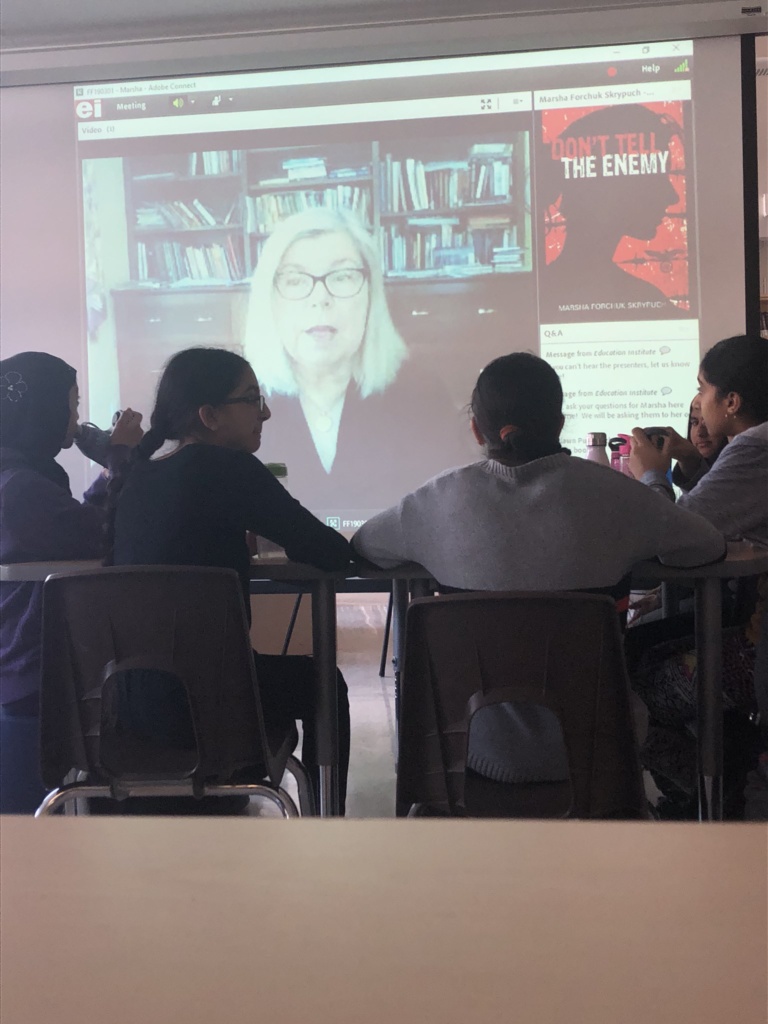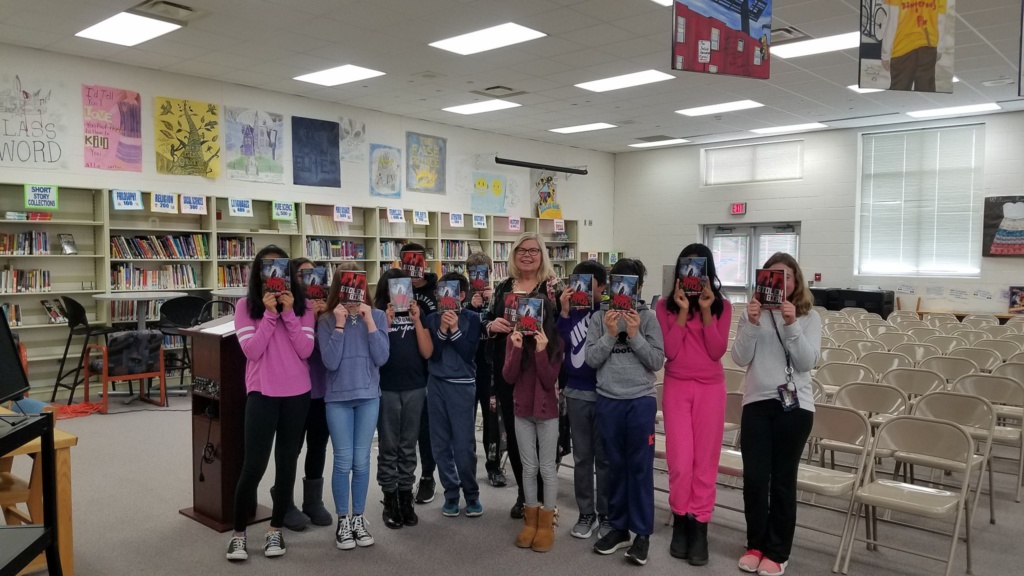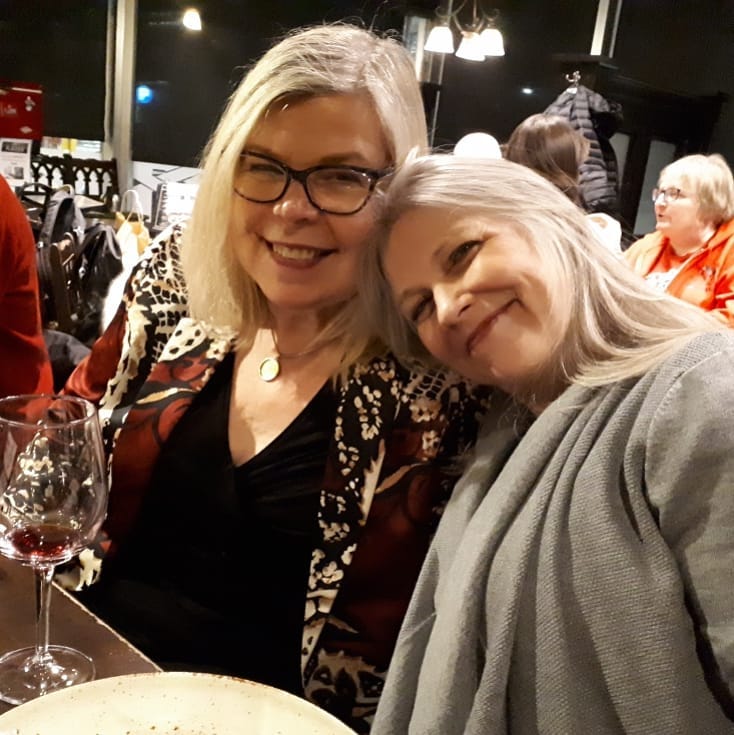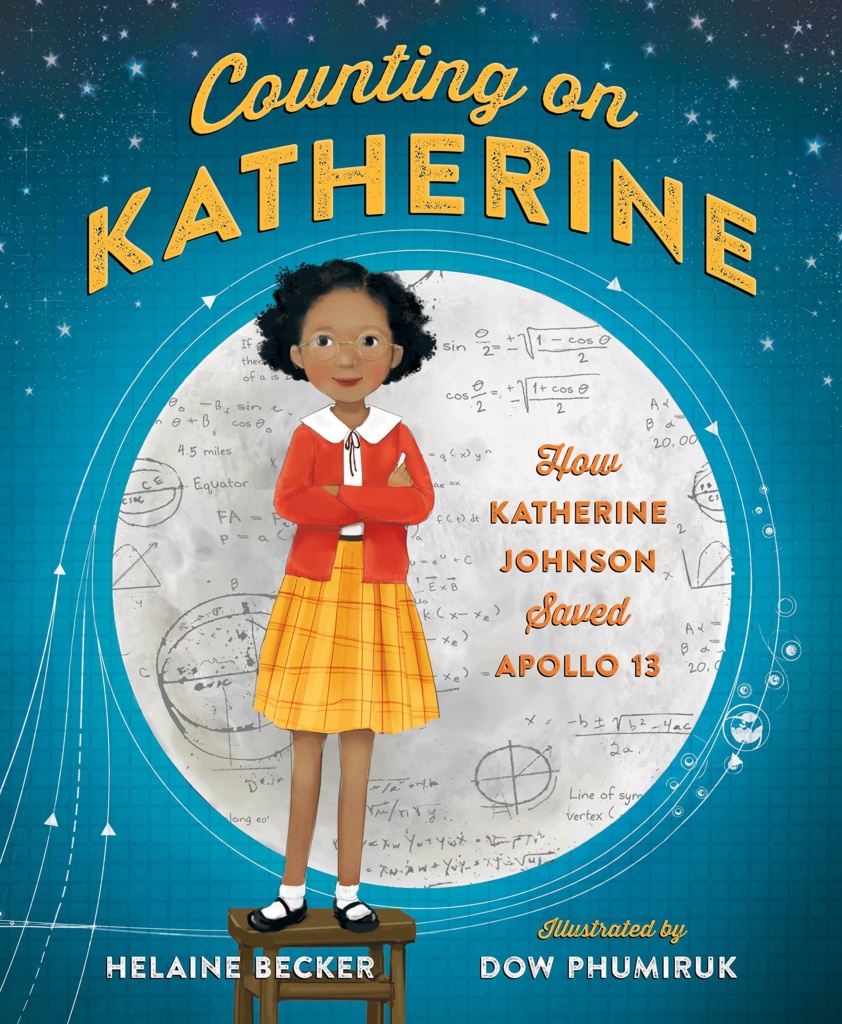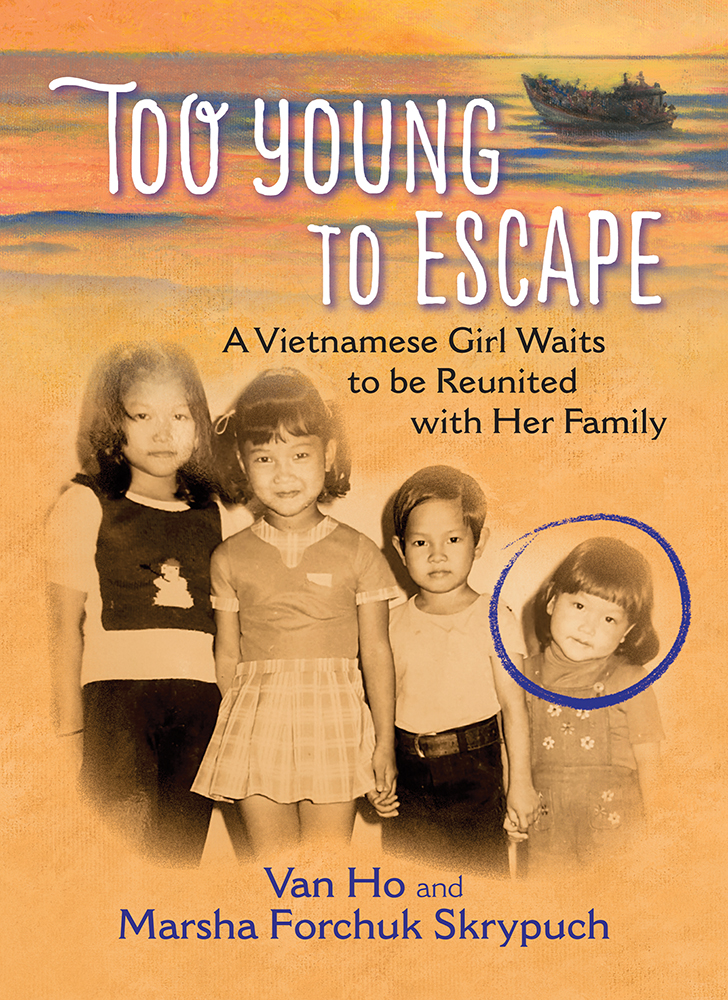After speaking about Stolen Girl all week, I switched hats on Friday and spoke to Red Maple readers about Don’t Tell the Enemy. It was an interesting experience, speaking to such an array of school groups without being able to see them!
Category: News stories
Chicago Scholastic Book Fair Visits
Just got home from 4 busy days of school visits in and around Chicago. I had some amazing experiences, meeting kids who will grow up to be our leaders and educators who are committed to making that happen. It was awesome to get to meet the Chicago Scholastic Book Fair team who work very hard to make reading accessible to all kids. An inspiring visit.

Granger Middle School 
Murphy Junior High 
Gregory Middle School 
Plum Grove Junior High 
Westview Hills Middle School 
Plum Grove Students conducting an interview 
with the principal of Herrick Middle School 
Bednarcik Junior High 
At Granger Middle School with Joan Fitzgerald 
Bednarcik
sample order form
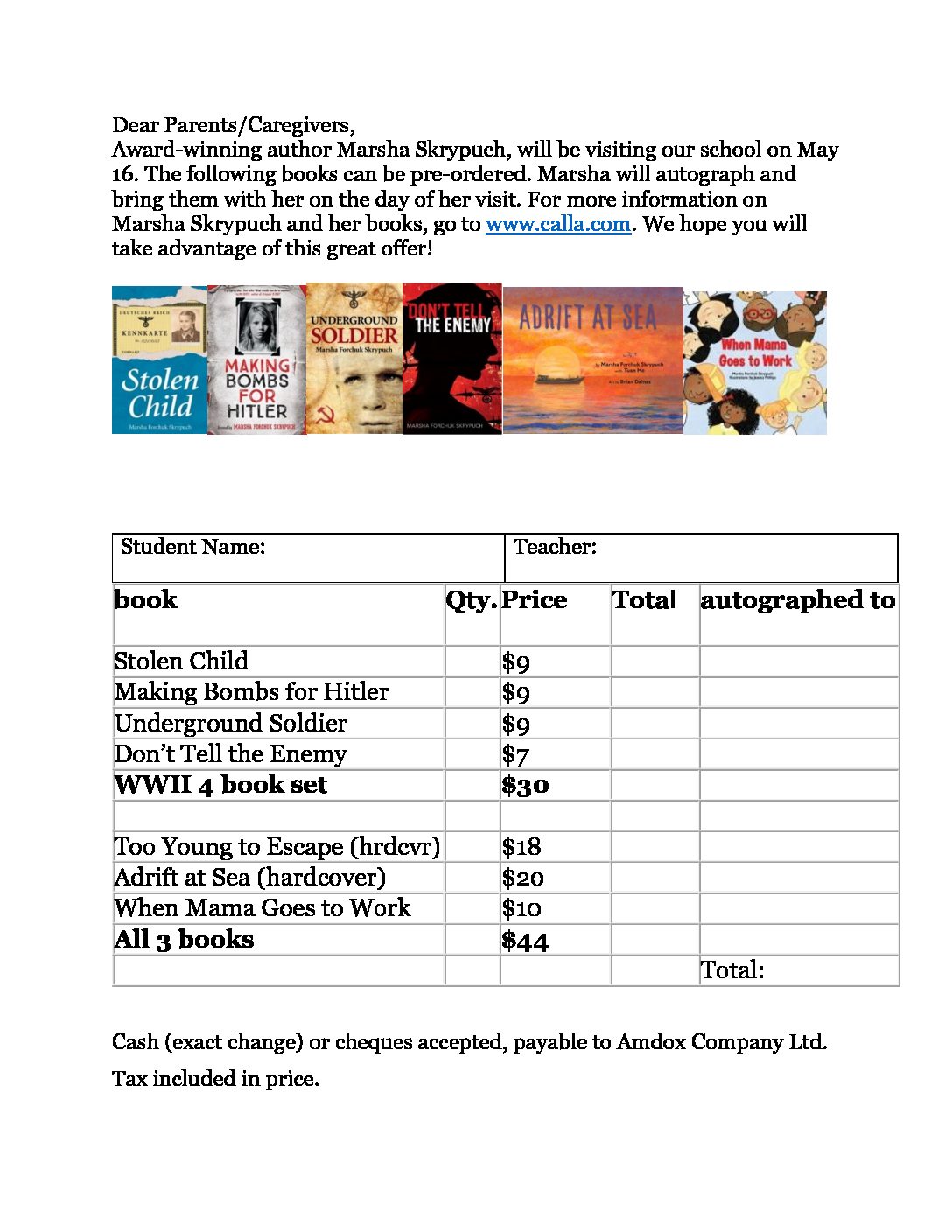
Dave Jenkinson interviews Marsha, April 5, 2002
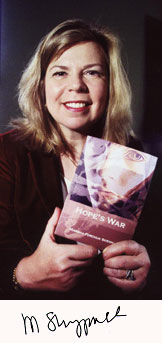
Marsha Forchuk Skrypuch
Profile by Dave Jenkinson for CM April 5, 2002.
Marsha was born and raised in Brantford Ontario. In Catholic elementary school she was labelled as slow. “I couldn’t read, and so it was easy to be labelled ‘slow.’ I had some kind of learning disability. It’s not dyslexia, but it’s something like that. I could read words by looking at them, but I didn’t sound things out. When I picked up a book, I always wanted to read it from the back. You could read those awful books with Spot, Dick and Jane backwards, and they made just as much sense backwards as frontwards. I never really got the whole patterning thing of reading. The weird thing is that my mom and dad are both avid bookaholics, but I just decided that there wasn’t anything in reading for me because I thought, ‘Nah, it doesn’t make any sense. It’s not interesting.’ And so I didn’t read. I shared a bedroom with my sister who’s a year and a half older than me, and we had bunk beds. She didn’t think I had to read either if I didn’t want to. She would do my homework for me and would read me what I needed to read so I could ‘think’ it when I went to school. I faked it until grade four, and then they had those standardized tests and caught me. I think I handed the test in blank. That was also the same year that my parents split up, and I failed.”
“When I went to school for the second time for grade four, it was really embarrassing to be the oldest in the class. Before that, everyone thought that I was really smart. I just decided that I couldn’t learn how to read in a normal way, like by asking for help, and that I had to do something more dramatic than that. I went to the public library to the children’s section where the books were all alphabetical by author. I started at the ‘A’s’ and kept going until I found a really thick book, and ‘Dickens’ in the ‘D’s’ was the thickest. I took a year to read Charles Dickens’ Oliver Twist, and it taught me how to read. It’s because you couldn’t start from the back and there was a story. It wasn’t the words that carried me on. It was the story. So it wasn’t my fault that I didn’t learn how to read. It was Dick and Jane’s! As soon as there was plot, then I could read and thought, ‘Wow! This is entertaining. There is something here.’ I read more Dickens and then started on Louisa May Alcott and Brooks’ “Freddy the Pig” series. I never really got past about ‘D.'”
“My parents were divorced, and, therefore, I was ‘a product of a broken home.’ I was attending a Catholic school and doing as the school expected, which was ‘poorly.’ I was living ‘down’ to their expectations. It still really gets me frustrated. When I do school readings, I usually bring my grade 8 report card that shows I got ‘D’ in writing. That’s handwriting, but still the kids get a kick out of it. On the back of the report, it says, ‘Marsha must learn to be punctual.’ I show the report to them and tell them that I failed because so many kids are labelled really quickly and just become what they’re told they are. My saving grace is my mom. Even the year I failed, she bragged about me and found one good mark on that report card, an ‘A’ in art. She told everybody in the neighbourhood that I was this genius when it came to art. She showed my pictures, and she was sincere about it. She never once said anything about failing. She just said, ‘I know that you’re smart, and so don’t worry about it. It’ll happen.’ She also had this thing she said, ‘You don’t want to be a hothouse flower,’ which was her way of saying, ‘Everybody’s ready when they’re ready, and you don’t want to push it.’ My experience in school is probably why I write the kinds of things that I write because I’m always writing about an underdog situation and showing how appearances can be deceiving.”
“The very first thing I wanted to be, once I read a book, was to be a writer. I wanted to write something like Charles Dickens did. The one problem that I had with him was that I thought he was too wordy. But I just loved that nitty-gritty underdog point of view and his way of telling a story and making you step into the shoes of a character that would otherwise be someone that was unsympathetic. Even 20 years after reading the book, the characters come back to you because they’re so vivid. They’re real. They’re not just characters. They’re people.”
“As soon as I finished grade eight, I went to a public school. I was just so relieved to get away from the whole Catholic thing. Don’t get me wrong. They were good people, but there was a fair bit of hypocrisy there. During the whole time I attended Catholic school, I never ever told anyone that my parents were divorced because you couldn’t say the ‘D’ word there. I didn’t know of any other kids in the school whose parents were divorced. My sister and I had a pact. We decided that we would tell everybody that our father was on a business trip, and so he was on a ‘business trip’ for four years. On Sundays, he would come and pick us up and take us, and sometimes some of the kids from our school, to things, but, as far as the other kids knew, for the rest of the time, he was on a business trip. When I got to grade nine, it was great. I’d say, ‘Hi. My name is Marsha. My parents are divorced.’ It’s like I could let it out.”
During high school, Marsha wrote for her high school’s newspaper. “Basically, I wrote satire, and actually I got into a lot of trouble for it. I really liked high school. I got elected to the student council in grade nine, but I was always the one that would get on everyone’s nerves because I didn’t like the ‘establishment.’ I would do stuff that was kind of funny and would make fun of whoever were the real popular ones. One year, the student council president and vice president were really full of themselves, and so for the school paper I analysed their handwriting. Actually it was very sincere, and I said some nice things, but some of the things, well, what could I do, ‘it’ was right there in their handwriting, right? While everybody was chuckling over this, the two of them were so mad at me. Then I did this other thing where I wrote as if it was serious, and it wasn’t. I just said, ‘Everyone should come to school without clothing on because then there wouldn’t be any sexual abuse.’ Oh, I got into big trouble for that.”
“In grade 10, I got sent to the vice principal’s office for answering too many questions in English. For that, I got put into the enriched English class which was just wonderful. Being in that class opened a real door for me because all of a sudden I could do more of what I wanted. I was really encouraged by the teacher, Mr. Ed Neely. I then knew that I had to do English at university. There was nothing else, except maybe art because that was my other strength. But I didn’t know about the Ontario College of Art, and, because no one else from my family had ever gone to university before my sister and I did, it was sort of like, ‘I’ll do English because I “know” about it.'”
At the University of Western Ontario, Marsha took a B.A. Honours degree in English with the intention of becoming a writer. “My dad was not very happy with that. He thought that people should have careers, and being a writer wasn’t a career. He would say, ‘What are you going to do with that? Be a teacher?’ which he also didn’t think was a very good idea. ‘Why don’t you have a profession? Why don’t you do something?’ And I just said, ‘Like chill out. This is what I’m going to do, and I’ll figure it out for myself.’ However, when I graduated in 1978, I couldn’t get a job. I did take a job as an industrial sales rep, and I did really well, and my father was quite proud of me then. But the English degree really helped because you can sell tools if you’ve read Shakespeare. And, if you’ve read Beowulf, you can read The Cutting Tool Guide. I was actually considered the expert in southwestern Ontario for cutting tools and had these huge accounts.”
“These were the days before cell phones, and so I would call into the office to see if there was any emergency with any of my accounts. They might say, ‘Yah, so and so needs their grinding wheel.’ These wheels are big, some of them 150 pounds. Because I was the only woman in Canada, likely the only woman in North America, doing this job, the men in the plant didn’t like that fact. So I’d stroll back to the office, get the wheel and take it back to the plant. The men would see me coming and go, ‘Oh, it’s her. We’re going on break now.’ All the people in shipping and receiving would just leave, but I’m strong. I’d pick up the grinding wheel, rest it on my hip and take it right in.”
Literature-loving Marsha found at least one advantage to being a female in this role. “I never ever had to have lunch with anyone. Since everybody I called on was male, they didn’t want to be caught dead with me because there’d be ‘rumours.’ As I was travelling all over the place, I used to take all my novels to read. I’d have all my lunches paid for, and so I’d just sit in a restaurant, eat lunch, and read my big fat novels. When I was going on all the sales calls, again I’d have my big fat novel, and I’d sit reading in the waiting room until I went in. Then I’d just change my ‘head’ and start talking about cutting tools.”
“After four years, I started to hate my industrial supply job. There are only so many times you can hear people say to you, ‘So, what’s a nice girl like you doing in a job like this? Ha-ha-ha.’ When you’d walk in, it was sort of like being a penguin in Jamaica. People would react to you so weirdly because you were so uncommon, and I just got tired of it. What I really enjoyed about the job was when someone would ask me some iddly-piddly little thing. Other reps, when they were asked, would say, ‘Yah, yah, I’ll find out,’ and then they never did. I kept meticulous notes, and I found the answers to all of those little things, and that’s actually how I ended up doing so well in sales. But during the early ’80’s recession, I was making all these sales calls and not making money. It was just tedious beyond belief, and so I just decided to go back to school.” In 1982, Marsha enrolled in a Master’s of Library Science program at the University of Western Ontario, and, while she followed a special libraries pattern, she did take a course in children’s literature.
“That was the first time that I really had experience with children’s literature. Remember that, as a child, I had been vaccinated against children’s literature as a form by Spot, Dick and Jane. Another children’s book I did try and read as a child was The Cat in the Hat. That book terrified me, and I had nightmares. And so I had another reason for deciding that reading wasn’t for me. Not only is there no story, but, when there is a story, it’s terrifying. When you think about The Cat in the Hat, the theme of that book is child abandonment, and then there’s this cat terrorizing the kids. There’s a lot of stuff going on there. I also took a popular literature, reader’s survey kind of course because I’d never read a western or a romance. I’d only read these 18th and 19th century big fat novels. ‘If I’m going to be a librarian,’ I thought, ‘I had better read some other books.’ I loved the children’s literature course which was a real eye-opener for me.”
Marsha’s cultural roots, something not part of her growing up, have come to play a major role in her writings for children and adolescents. “My paternal grandfather came to Canada in 1912 and was interned as an ‘enemy alien.’ My dad’s siblings were all renamed with English names by the school system. My dad’s name is Myroslaw, and he’s Marshall. A sister Alice is supposed to be Olga. Feschuk became Forchuk. They weren’t allowed to speak Ukrainian at all. Because my dad literally had the Ukrainian beaten out him by his teachers, he didn’t want my sister and me to learn Ukrainian. My mom’s not Ukrainian. She’s potato famine Irish, as Canadian as they come, but she thought it was kind of neat that my dad spoke this other language and thought we should have that culture. But Dad put his foot down and said, ‘No. I don’t want it for my kids. I want them to Canadian.’ I had to learn all the Ukrainian culture stuff myself through the backdoor. My husband’s Ukrainian, and his parents came over after World War II. I did take Ukrainian language lessons with two different tutors, but I’m not fluent. I get more things wrong than right. However, I can read Ukrainian enough to help with research.”
“Not being raised up in the Ukrainian culture actually opened up another door for me too. When I was growing up, it was just something that wasn’t talked about. I didn’t know about my grandfather’s being interned until after I had done my Master’s degree in Library Science. Someone did an op ed piece in the Globe & Mail about Ukrainians in Canada being interned during World War I. I read it and called my dad and asked, ‘Did you know about this?’ And he replied, ‘Well, you know that your grandfather was interned ?’ And I said, ‘No.’ And he said, ‘Don’t you remember the whole thing about being imprisoned unjustly? ‘ And I said, ‘Yah.’ Dad said, ‘Well, what do you think that was?’ And I responded, ‘I thought it was like “in prison,”‘ because I did remember my grandfather talking about that event but not this. I realized that there was all this really interesting stuff that I didn’t know anything about, not specifically my family, but Ukrainian history. It was just an area that no one had really explored in a North American sense.”
While Marsha had married in 1981, it was in 1984 that her son was born. Although Marsha wanted to go back to work, Orest, her husband, encouraged her to stay at home and “just be a mom for a little bit.” Marsha did accept Orest’s suggestion, but she soon found herself engaged in activities beyond mothering. “I invented a breast pad and sold it all over the place. At the same time, I was doing book reviews for The Expositor, the Brantford paper, because I was just going stir crazy. Now, that’s not to say that being a mother wasn’t fulfilling. It was that I just needed something else, and so I started doing book reviews. That was when I really got into the whole thing of children’s literature. Initially I was reviewing anything that no one else wanted to do. After a while, the paper started letting me choose, and then I just started selecting a whole pile of children’s books.”
“I did the reviewing for a few years, and it was while I was doing the reviewing that I started writing myself. I had to stop doing the book reviews because I found they were taking too much time. But the reviewing’s actually how I met Gail Winskill who’s my mentor. At the time, Gail was at Scholastic. I’d just come to the conclusion that I wasn’t going to be doing book reviews any more, but I had written ‘Shadows in the Sand,’ a big manuscript about Armenia in the early part of the twentieth century, and had been sending it out to various places. It was getting rejected though I did sell a movie option on it to a small Hollywood production company. While I was doing that, I also wrote a story, ‘The Red Boots,’ which was based on an incident in my father’s life, but, in terms of genres, I didn’t know what it was I had written. Because Gail had been one of the marketing people at Scholastic who had been sending me books to review, I called her and said, ‘You don’t know who I am, but I’ve written something and I don’t even know what it is. I’m wondering whether you would be able to tell me where I should send it.’ And Gail said, ‘I know who you are. I’ve been reading your book reviews, and we really like them. Send me that story. I’ll tell you what it is, and I’ll tell you where you should send it.'”
“I thought, ‘Great,’ and so I sent it to her. It got kicked around Scholastic for a whole year, and Gail kept calling and saying, ‘We still haven’t rejected it. We really like it. It’s a really nice story, but we don’t know what it is.’ Finally I got a letter from Don Sedgwick, then the director of publishing, who said that he also really loved this story, but it was 3000 words. It wasn’t a picture book. It wasn’t a young adult. It wasn’t anything. But he did add, ‘Any time that you have something, send it to us.’ Then Gail ended up at Penguin, and I wrote Silver Threads which she saw and loved. That’s why I was at Penguin. I wanted to be wherever she was, and that’s why The Best Gifts is with Fitzhenry & Whiteside because I followed her. I’ll follow her to the end of the world. She’s got a real vision and a real gift, especially when it comes to picture books. She doesn’t like my novels. She says, ‘Why do you write that stuff? It’s so sad?'”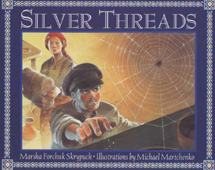
Silver Threads, Marsha’s first published picture book, had its beginnings in that op ed piece in the Globe & Mail. “‘The Red Boots’ was a story that my dad had told me over and over when I was a kid and so I did more research on it and wrote it as a short story. That’s when I read that Globe & Mail article about the internment of Ukrainians. I just couldn’t get that out of my head. By then, I had actually finished one unprintable novel, ‘Shadows in the Sand,’ and had started on another unprintable novel, a mystery. I’d got about 30,000 words into the mystery when, via the Literary Forum on Compuserve, someone asked, ‘Does anybody know any folktale about a spider. I’m especially looking for ethnic folk tales about spiders.’ I thought, ‘I know one,’ and so I related the one about the spider decorating the Christmas tree. I went to bed that night, and, when I woke up in the morning, that story and the whole internment thing had kind of blended together. I didn’t get dressed the entire day. I had my housecoat on and my pyjamas, and all that I did was type that story. I did the first draft that day and later did 64 more drafts and revisions, but that story of Ivan and Anna and their homesteading in Canada came from those two things just coming together in a dream. And as for that mystery novel I was writing, I’ve never even opened up the file again.”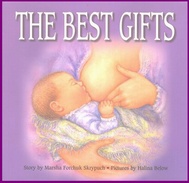
“The Best Gifts was my next book. Gail had just started at Fitzhenry & Whiteside, and I think it was the very first book that she did with them from start to finish. She wanted to do something that was not folktale-like. She wanted something contemporary and said, ‘See what you can do.’ I wrote it, and she gave some really good editing advice.” The slim picture book follows the life of Sara from her birth though to her becoming a mother herself. At each of the milestones in Sara’s life, she is given presents, and while they are appreciated, the true gifts are the “love and warmth” that surround her. As Sara concludes, “the best gifts can never be bought.” The “unbought” gift that opens and closes the book is a mother’s milk.
“I’m really pleased with The Best Gifts. Interestingly, it has probably sold more than all of my other books put together. In the United States, while the buyers for the chain stores took it, when The Best Gifts got to the individual stores, they refused to put it on the shelves, and so it got shipped back en masse. In spite of that, the book has done well. It’s sold by word-of-mouth more than anything. The Best Gifts is an approved book by the La Leche League International. It’s totally different than anything else I’ve done. When I do school readings, I don’t even bring it with me because of the cover. There’d be too many kids giggling, but I’ve done a lot of readings to nursery school kids and lactation consultants. It’s got that very special market.”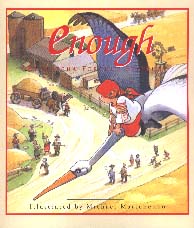
With Marsha’s third picture book, she again returned to Ukrainian history, specifically the famine in Ukraine in the 1930’s. Written in 1995, two years before The Best Gifts, Enough did not appear until 2000. Although Enough is based on an old folktale, Marsha said that the original was too convoluted to become a single story. “A stork in Ukrainian folklore doesn’t bring babies like it does here. It brings good luck. In this old folktale, a stork took a peasant man to a land of gold coins where he filled up a bundle of gold coins and got back on the stork. When he was half way over the ocean, the stork said, ‘I’m hungry. Feed me.’ The man took out his knife, cut a strip off his leg and fed it to the stork. After he got home, his greedy brother wanted to make the same trip, but he wouldn’t feed the stork his own flesh and so fell into the sea. But that was only one tiny part of this huge story.” Marsha points out that “the end papers are of an actual scarf. It’s not a painting. It’s a photograph. People from Toronto’s Ukrainian community went through quite a bit of trouble on my behalf looking for an authentic one that would have been from the famine area.”
Marsha provides an explanation for why the 1930’s famine in Ukraine is so little known in the West. “I think it was in 1938 that Stalin called a congress of all the blind minstrels in Ukraine. In those times, the blind minstrels were like Homer. They would have these huge long poems and would go from village to village reciting them. Basically for people who became blind, this was a career choice for them. They would memorize their stories, and then they would transfer them all over the place. During the Stalin era, they also got a good repertoire of other political stories that Stalin wasn’t really too keen on being transported all over the place. Blind minstrels equalled early internet, and so Stalin called this congress of blind minstrels. Over 300 came, and Stalin had them killed. What that did, besides killing the people, it killed the stories. Part of the whole propaganda technique is that, if you dehumanize someone, then it’s OK if they are killed. Stalin dehumanized the Ukrainians, and then he also made sure that no one would rehumanize them because he killed the people, the storytellers, journalists, authors and artists, who could. That’s why I had to tell the story and think of a way that I could tell it so that someone could feel what it would be like if they were Marusia with her dad on their farm near the village and all the food had just been taken out of their house.”
“And kids love Enough. It was actually a grade five child in 1995 who gave me the solution of having the grain buried in the graveyard. I always had a workshop at whatever school my son was at, and we would all share our stories. I was working on Enough and said to them, ‘I still can’t figure out how she’s going to hide it.’ This one boy suggested burying it in a grave, but he said it sort of like a joke because he said, ‘This is really grim,’ and I’m thinking, ‘Yes, it is G-R-I-M- M.’ It’s just perfect, and it’s also like the novel The Secret of Santa Vittoria where the Italians hide their wine from the Germans in World War II. It’s so symbolic.”
It was while she was in library school that Marsha encountered Robert Munsch’s The Paperbag Princess. “It was one of the first picture books that I read, and I fell in love with Michael Martchenko. It’s been such an honour for me to have him have illustrate two of my books, including Silver Threads, my very first book. It was like a dream come true because I hold that man in such high esteem. The Paperbag Princess story, itself, was revolutionary in terms of children’s literature, but Martchenko’s illustrations were just as revolutionary. He’s a very talented man. A lot of people don’t realize he doesn’t just do cartoony things. It was Angela’s Airplane that made me realize how well he could draw. It’s a silly little thing, but it was the controls on the airplane when Angela was sitting in the pilot seat that told me that Michael really paid attention to detail and could do things very precisely.”
“I have done two books with Michael, both historically based, and I know how well he does his research. Enough is really neat because Michael wanted it to be ahistorical and historical. The bad guys are never the Red Army, and the bad officer looks almost more like a Nazi than a Soviet. I thought that approach was really brilliant on Michael’s part. Basically what he’s saying is, ‘Bad guys are all alike.’ I had hoped that no one else would illustrate Enough except him because I couldn’t think of anyone else who would have the right touch. At the book launch at the Toronto City Hall, I said that I had visualized Michael Martchenko’s illustrations when I had written the book. When he got up, he said, ‘Well, I wish you had told me what I had drawn before I had to go and do it. It would have made it a lot easier.'”
In addition to her three picture books, Marsha has authored two YA novels. “I was writing novels the whole time I was doing the picture books. I’ve got eight picture books texts written, all lined up, but they take a different kind of thought process. Usually I’m writing a picture book and a novel at any given time. I was always writing the novels, but I couldn’t sell them to publishers because young adult fiction was a real hard sell. When I finished The Hunger, I had some publishers who said, ‘Well, you know, Armenians aren’t very marketable. Find a more marketable ethnic group and write your novel about that group.’ And I said, ‘The whole point of this book is that it’s a hidden genocide, and it was the first genocide of the twentieth century. I didn’t know about it, and that’s why I have to write about it.'”
The Hunger is a mixture of realistic and historical fiction with a smidgen of fantasy binding the book’s two time periods together. Paula Romaniuk, 15, who is suffering from an eating disorder, encounters Marta, a starving 13-year-old orphan Armenian girl living in 1915, a time when the Turks were slaughtering the Armenians. About writing the novel, Marsha says, “I don’t have a drop of Armenian blood, and I didn’t even know any Armenians, to know that they were Armenian, until about 1990 when I did a profile piece for a local magazine. I was doing this ‘coming to Canada’ kind of thing. I would interview people about why they or their parents or grandparents chose to come to Canada. I find that just a fascinating topic. A man approached me, saying, ‘You have to interview me about my dad.’ And I said, ‘Why?’ He replied, ‘Because he was a Georgetown Boy.’ And I asked, ‘Who’s that?’ Once he told me, I had to write the story, and I had to write it more than as just a little article. I had to write a book about it, and so that’s how The Hunger started.
“The Hunger also began with the unpublishable adult novel, ‘Shadows in the Sand.’ I didn’t even think of the anorexia part until I was doing a book tour for Silver Threads and Princess Diana and her eating disorder were in the news. Then there was the whole concept of having someone who considered food their enemy, and then have the enemy take food from them. To me, the character development that Paula goes through in the transition when she steps into her great grandmother’s shoes just makes the book work. Once it clicked in my head, I thought, ‘This is the way to do it.’ For me, it was also a way of making something, the Armenian genocide, that everyone had already shoved under the carpet and really didn’t want to talk about any more into something that they could talk about because it was seen through a filter that people were sympathetic about.”
“Writing The Hunger was also a real learning experience for me because I didn’t know anything about eating disorders, and so I had to find someone who was anorexic. I called a local counsellor and told her what I was doing. I interviewed her and said that I would really like to talk to someone who has gone through this experience, and so the counsellor put the word out. This woman, Heather, came forward, and so that’s how I found her. We’re really good friends now, and she’s said that doing the book made her feel that perhaps what she had gone through wasn’t a total waste because maybe she could help someone else. She’s even done public speaking things about her experience. She’s in her 30’s now, but she was anorexic as a teenager. I met her when she was about 29-30, and she was in the midst of an episode. Her neck was like my wrist, and so she was admitted to Homewood, just like in the book. All of Paula’s tricks in The Hunger were Heather’s, things like using the wooden spoon to vomit so you don’t have the scarred knuckles from bite marks or putting Visine in the eyes.”
“I interviewed not just counsellors but also psychiatrists who dealt with people with eating disorders. They said that there’s a family type that goes along with someone with an eating disorder, and there are some forbidden topics, like food, marks or appearance, that you’re never supposed to talk about with someone who has an eating disorder because these subjects trigger the whole thing with them. It was also interesting to compare Paula’s kind of starvation to what her great-grandmother, Marta, was going through because it was an entirely different kind of hunger. Starvation’s a completely different thing when it’s imposed on you compared to being self-imposed. There are never eating disorders in places where there is hunger. Doesn’t that say it all? It’s when there is that complete emotional anorexia in a culture that you can have an eating disorder. I loved writing that book. To me, to be able to step into the shoes of someone like Paula and Marta and to explore what it would be like it’s just a wonderful pleasure and it’s an honour to be able to write. Then to have someone want to publish it and people want to read it is really neat.”
“Right now I’m doing the sequel to The Hunger. Called ‘Nobody’s Child,’ it will be the grandmother’s story, and it’s all set in the past. I’ve got 25,000 words of it done already. I hadn’t done The Hunger as historical fiction because that genre was harder to sell. With ‘Nobody’s Child,’ I thought, ‘Well, I’ve got five books out now. For goodness sakes, I should be able to sell books.’ When I wrote ‘Shadows in the Sand,’ that 130,000 word ‘Armenian’ manuscript, I thought it was an adult novel, but, since I’m not a very adult person, there’s a problem there and so it never got published. I had taken just a tiny little portion of ‘Shadows,’ one of the character things, and made that into the past part of The Hunger. When I decided to do the sequel entirely in the past, I looked through the adult manuscript again and pulled out 60,000 words. The writing is so bad in ‘Shadows’ that it makes me cringe. I have it as a back file, and, as I’m writing the sequel, I’ll read ahead and then close it because I don’t even want it there because I’m writing everything new. But rereading the old manuscript reminds me of the way that the characters did the various things. There’s also some really good research that I had done for it. What I’m writing is the story of Mariam and Kevork because they’re both kind of left in The Hunger. She’s taken on a horse by the Captain of the Young Turk army, and you never hear what happens to her again, but you know that she’s survived. It’s the same with Kevork. The sequel is their intertwining tales in the past.”
“I wouldn’t have had the ability to write ‘Nobody’s Child’ all in the past before. I think another reason why I was always doing the contemporary and historical together is that you can step into the past with just a flash, but, when you’re telling the story totally in the past, there’s a whole pile of research needed. I’m doing all that research now. When I wrote The Hunger, I wasn’t getting a whole lot of help from the Armenian community. I called various people, and they were very suspicious, sort of like, ‘Why do you want to write about us?’ When The Hunger came out, all these people, historians and academics, came to my book launch and said, ‘If you ever write another one, call if you need any help.’ When I was doing the book in 1990, before the Internet, and I was looking for Armenian history stuff, you couldn’t get anything. I think our local library had three books on the Armenian massacres.”
“My second novel, Hope’s War, is about a pretty controversial topic, but, if I don’t want to write about it, then I’m not going to write it. I’m not going to write some skateboard adventure or anything like that. I will only write about things that I find fascinating, and what I find fascinating are bits of history that people don’t know about and that I don’t know about. That’s why I write about them. For me, to write a novel is like me reading a novel. If I can’t find it to read, then I’ll write it.”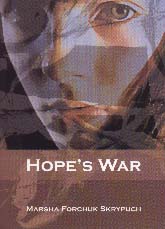
Hope’s War, Marsha’s second YA novel, deals with five members of the extended Baliuk family whose lives are thrown into turmoil when the grandfather, Danylo Feschuk, aged 78, is threatened with loss of his Canadian citizenship for allegedly having committed war crimes in Ukraine during World War II. The origins of this book reside within Marsha’s university days. “The first person who taught me Ukrainian was my roommate in university, and her father had been in the war. That was really my first exposure to people who had come from Ukraine after World War II and had been involved in that war. When the Ivan Demjanjuk case was in the news, her father said something really interesting that stuck with me. He said, ‘If they can say that Demjanjuk committed war crimes, they could say that anyone in Ukraine did because of what flimsy stuff they are basing their charges on.’ I didn’t know anything about the history of World War II in Ukraine, but his words stuck with me so that, when Canada started bringing the same kinds of charges, I started following along. It was also in the 1980’s just after the Demjanjuk thing that Canada had the Deschenes Commission, that I started getting people being snarky to me for being Ukrainian. It was the first time in my life I had ever had people direct ethnic hatred towards me. I’ve had animosity directed at me for having ‘divorced’ parents but never for being Ukrainian.”
“Consequently, I wanted to look into that ethnic discrimination as it was a subject that interested me. I also knew that questioning the actions of our government was something that was almost a forbidden topic which, of course, appealed to me even more. When I first started to do the research and decided that I was going to do it in terms of a young adult novel from a 15-year-old girl’s point of view, I had, at that point, wanted to find someone who was guilty of war crimes. I was writing the story from a 15-year-old’s point of view because she was innocent, and so it wouldn’t have mattered what Kat’s grandfather did. But then each and every war crimes case that I looked into, the accused wasn’t guilty, and so it was kind of wrecking my story. I know that sounds very shallow on my part, but, as a writer, you have to think in terms of plot too and also you want to think in terms of not making everything sound too all one way or all the other way. It would have been better had the grandfather been guilty because, in some ways, it would have made a more interesting story, but that’s not what happened.”
“I realized that the government wanted the semblance of justice, but they didn’t want to do the real justice because they knew it would get them into hot water. There are war criminals, but they are within groups that are very protected by countries, defence alliances like NATO, and trading partners, and so the government didn’t want to go there. It’s a thorn-thistle of problems, but they knew they could do it to a Ukrainian because no one is going to come to their defence. But what the government didn’t realize is that firstly there is no such thing as justice if it’s only a semblance of justice. Secondly, the people who are being targeted are really being abused. The charges and legal cases have totally ruined their lives and the lives of their whole family, and so that’s what the story became. It became something different that showed the whole domino effect of how one false accusation can have this ripple effect on a whole family and whole community. If there hadn’t been that hatred directed towards me, then I wouldn’t have written Hope’s War.“
While hatred provided the genesis for Hope’s War, ironically hatred in a new guise was present at the book’s conclusion for the galleys arrived on September 11, 2001. “You’re supposed to have the galleys back in 24 hours, and I couldn’t look at them. During World War II in Ukraine, there were thousands of villages destroyed, and each one of them was like a 9/11. As I was reading through the galleys, the monumental tragedy of 9/11 was in my head, and I could see that multiplied by thousands and thousands and thousands in Ukraine during the war, and no one cared. I just couldn’t stand it, and I couldn’t stop crying. What people don’t know is that the Ukrainians were caught between two enemies, and so it doesn’t matter who wins, you lose. Stalin was so angry with Ukrainians because they were anti-Communist, but they were anti-Nazi too. They just wanted freedom.”
Ian, the Goth figure in Hope’s War, is actually based on Marsha’s nephew. Adopting the Goth appearance, Marsha says, was his “twit filter. He’s a really good looking kid, like 6′ 2″, blonde hair, and very articulate. He’s just one of those smooth kids, athletic and good in school. He’s never had any trouble, and it kind of bugged him because people would just assume certain things about him based on how he appeared. He had some other friends who weren’t easy on the eyes, and he noticed the way that they were being treated. He just felt that he wanted to know what it would be like to be discriminated against, but he couldn’t make himself a visible minority, and so he made himself into something that was as bad as far as a lot of people thought. I really admire him for it.”
“While writing Hope’s War, I would tell my nephew different scenarios, and he would help me. For instance, with the Victorian knife, I did go to the army surplus store, and they had this Victorian knife underneath the glass plate. I was telling him about the knife, and he asked, ‘Did you buy it?’ and I said ‘No, and your character wouldn’t either because your character is non- violent.’ He replied, ‘Yes, I would buy it because it sounds really cool.’ ‘But,’ I asked, ‘I thought you were nonviolent?’ And he replied, ‘Yah, I am, but the knife just sounds nice.’ I thought, ‘Well, OK. I guess the book’s character has to have the knife,’ and so he bought the knife, but then I didn’t know what was going to happen. That whole scene where the character was beaten up actually did happen to my nephew’s good friend. The knife ended up being used in that way only because my nephew told me he would have bought it.”
Marsha has a most graphic way of describing how she approaches writing. “It’s sort of like you have a pimple that just has to be squeezed. I wait until it builds and it really has to be squeezed, and then I just do and it’s this ‘burst.’ I usually write on weekends. I’ll write all Saturday and all Sunday, and then I think about what I’m writing for the rest of the week. During the week, I do my research. I really use my dreams. If I’m at a problem spot in my book, then I go to sleep specifically thinking about that problem, and I’ll wake up knowing what to write next. I also don’t do a lot of rewriting anymore. I used to do a whole lot, but now I do all the rewriting in my head. I find that, by the time I get the time to write which is on the weekends, then I just write it, and I don’t have to do a whole lot of rewriting because I’ve already done it in my head for the whole week. That approach saves my hands because I’ve got chronic joint pain and thoracic outlet syndrome. My face goes numb, and I get pain all the way down my arms from writing too much.”
“I do an astounding amount of research for every book, and it’s very much hard work for me. I do it as needed. I’ll write myself into a corner where I can’t write any more because I haven’t done that part of the research. That next week is when I’ll do the things I need. For instance, for Hope’s War, I’d go and see how big a parachute is and how long it is when you pull it up and down the army surplus store. For that same book, I’d go and sit in on a hearing to see what stuff they actually wear and who sits on which side. I went and read the actual transcripts and then talked to a couple of historians. People will talk to me, but, when I started all this, people just thought I was a nut. When I call some place up, I always say that I am a writer, and then they’re helpful. You have to ask really specific and concrete questions if you are going to write the scenes. With The Hunger, I had to ask Heather again and again about the barf scenes. At first, she would just say, ‘I barfed,’ but, by asking more questions, I learned that there was vomit on the radiator and that Heather would have to very carefully hold her hair so that she wouldn’t get any vomit in it. After vomiting, she would immediately take a shower and change her clothes so that no one would know. These are important details because, if you are writing a scene and you want the person who is reading it to step right into the character, then you’d better know your character.”
Marsha says that her books have dual beginnings. Each book “always starts with character, and it always starts with historical incident. It always starts with them both, and what happens is I never know what part is going to move the story forward at any given time. I’ll find a premise that I find fascinating, and then I think about it a lot. ‘Well, what would it be like to be a 15-year-old girl whose grandfather was charged with being a war criminal?’ As I think about it, then the character evolves from the situations. The weird thing is that, when you let that happen, they’re not characters; they’re people. They become so, because, if a person has a certain reaction, they’re one person, and then, if they have another reaction, they’re someone else, perhaps her sister. There are only so many ways that people are going to react to a situation, and they become the people in your book.”
Marsha has the odd distinction of likely being the only Canadian author for juveniles who has ever received hate mail. “I got three pieces of hate mail for Enough. That made me really scared. I had also had hate mail in the eighties when I did a book review on Robert Conquest’s The Harvest of Sorrow: Soviet Collectivization and the Terror-Famine. It was the very first Western book written about the famine, and I had a death threat at that time. I had a local book launch for Enough, and the police showed up in uniform and stood behind me. While that was going on, my family was really freaking and asking, ‘Are you sure that you should be writing Hope’s War?’ What they were thinking was that perhaps it was the questions that I’d been asking around about that book that had generated the hate mail and not Enough. ‘Maybe you should abandon Hope’s War,‘ they suggested. ‘No, I’m not going to. It’s important to me. In fact, it’s more important than my life. I want to write about things that I want to write about. I will die, and these books will still be about. That’s important to me, and I’m not going to have some nut case shut me up.’ I just decided I would go ahead, but we did some safety things.”
Ironically, the hate mail happening actually assisted Marsha in improving the accuracy of Hope’s War. “Because I was going to have a hate mail incident in the book, I had called up the police and said, ‘Hi. I’m a writer, and I want to have hate mail show up. What would you do?’ They told me something completely and entirely different than they actually did when the real hate mail showed up.”
Books by Marsha Forchuk Skrypuch.
- The Best Gifts. Fitzhenry & Whiteside, 1998. Illustrated by Halina Below. Preschool-grade 3.
- Enough. Fitzhenry & Whiteside, 2000. Illustrated by Michael Martchenko. Preschool-grade 6.
- Hope’s War. Boardwalk Books, 2001. Grades 7 and up.
- The Hunger. Boardwalk Books, 1999. Grades 7 and up.
- Silver Threads. Penguin, 1996. Illustrated by Michael Martchenko. Preschool-grade 5.
This article is based on an interview conducted in Toronto on April 5, 2002.
Visit Marsha’s home page at www.calla.com
Marsha Skrypuch photo by Tom Frazer,

More pics from the Chicago visit
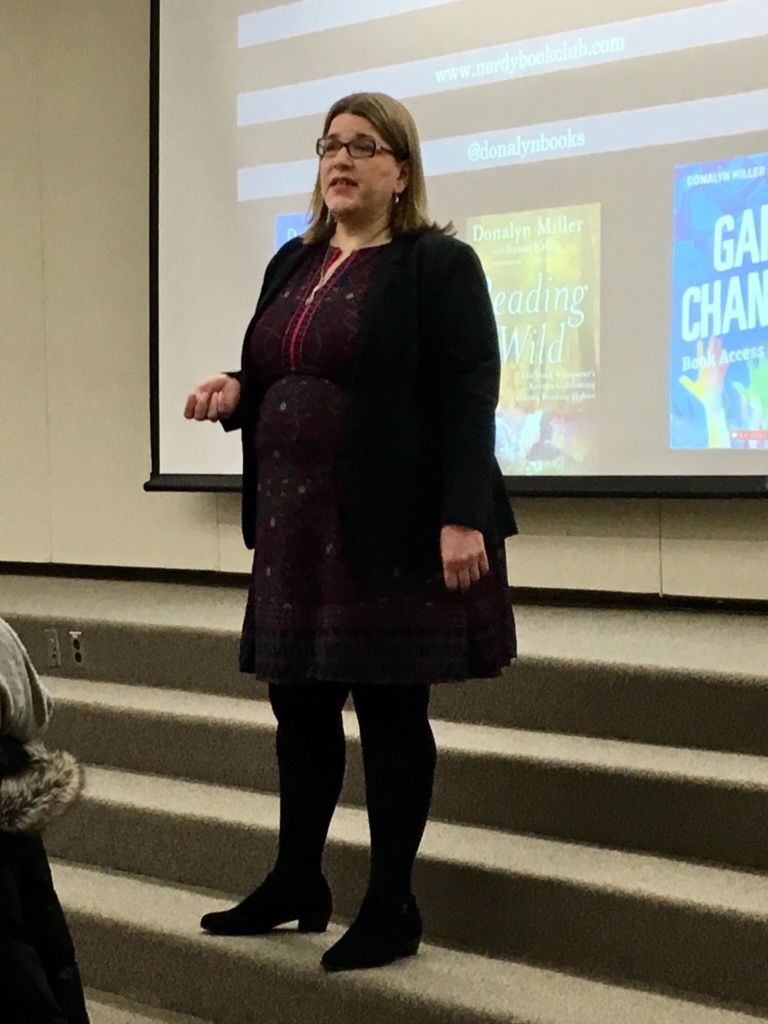
Visiting Michigan schools for Stolen Girl
It was such a fun week, visiting Michigan schools with Scholastic Book Fairs to introduce Stolen Girl! I met amazing students, educators and librarians and it was informative and fun to spend time with the phenomenal Scholastic Book Fairs team. Despite schools being canceled because of ice for two days, the Scholastic organizers were able to reschedule and rearrange so no one missed out. I am in awe! Here are some pics:
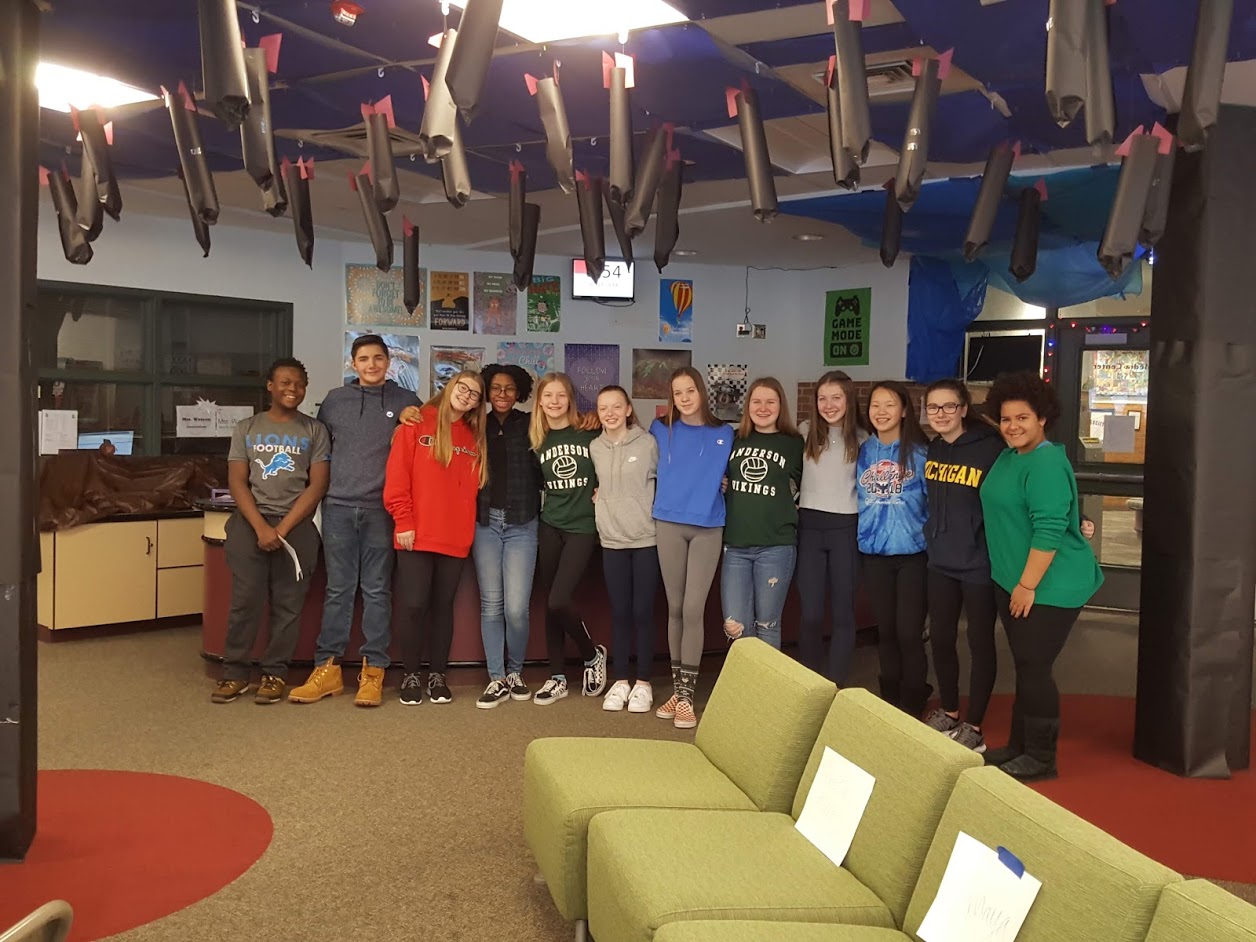
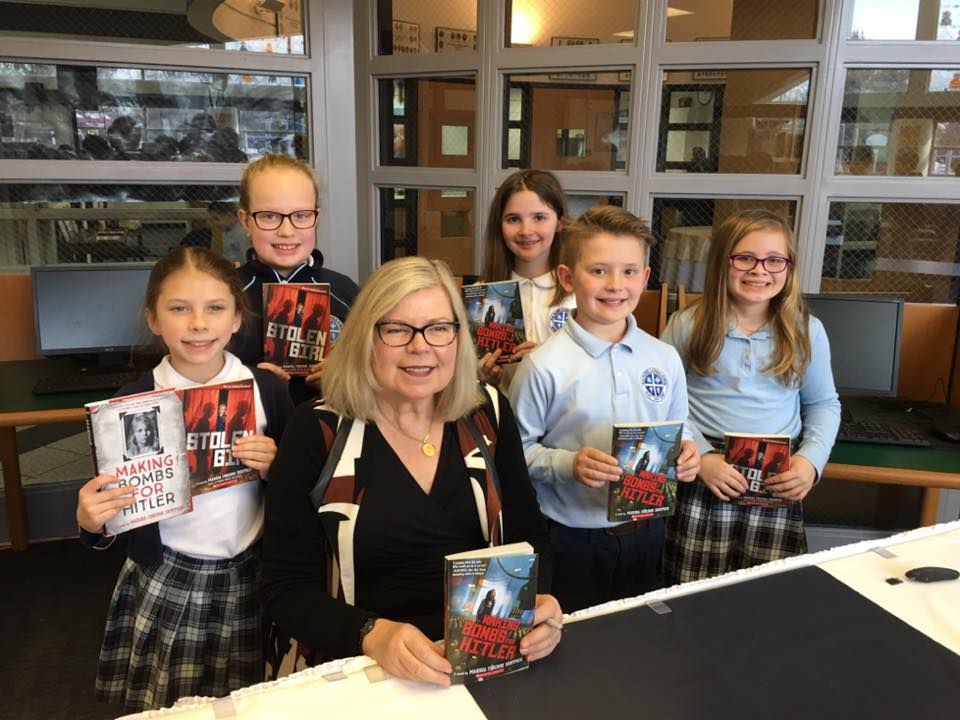
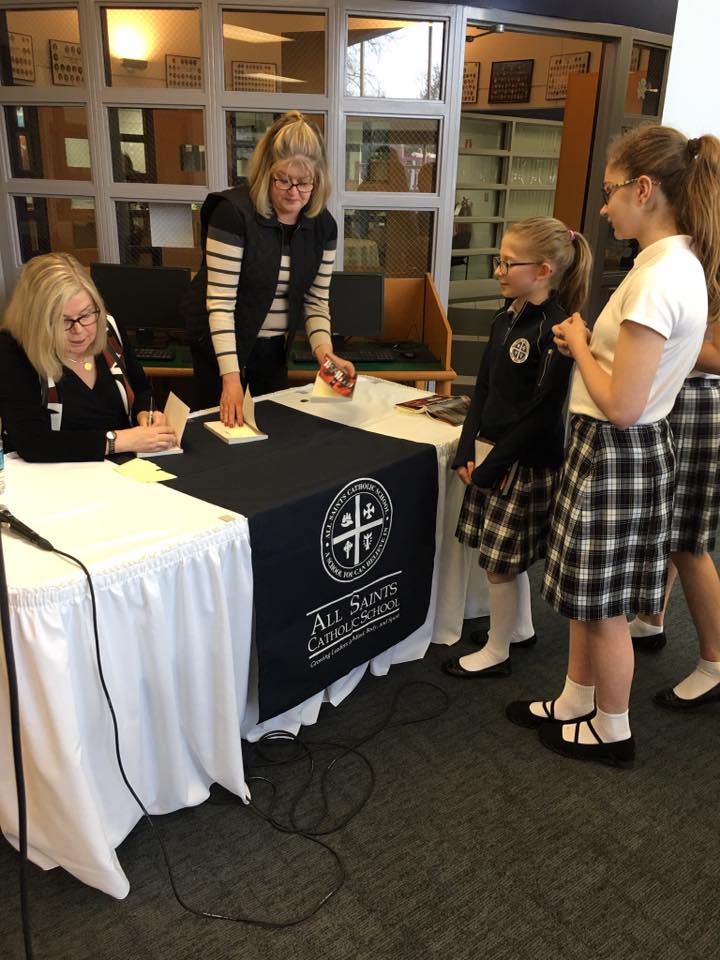
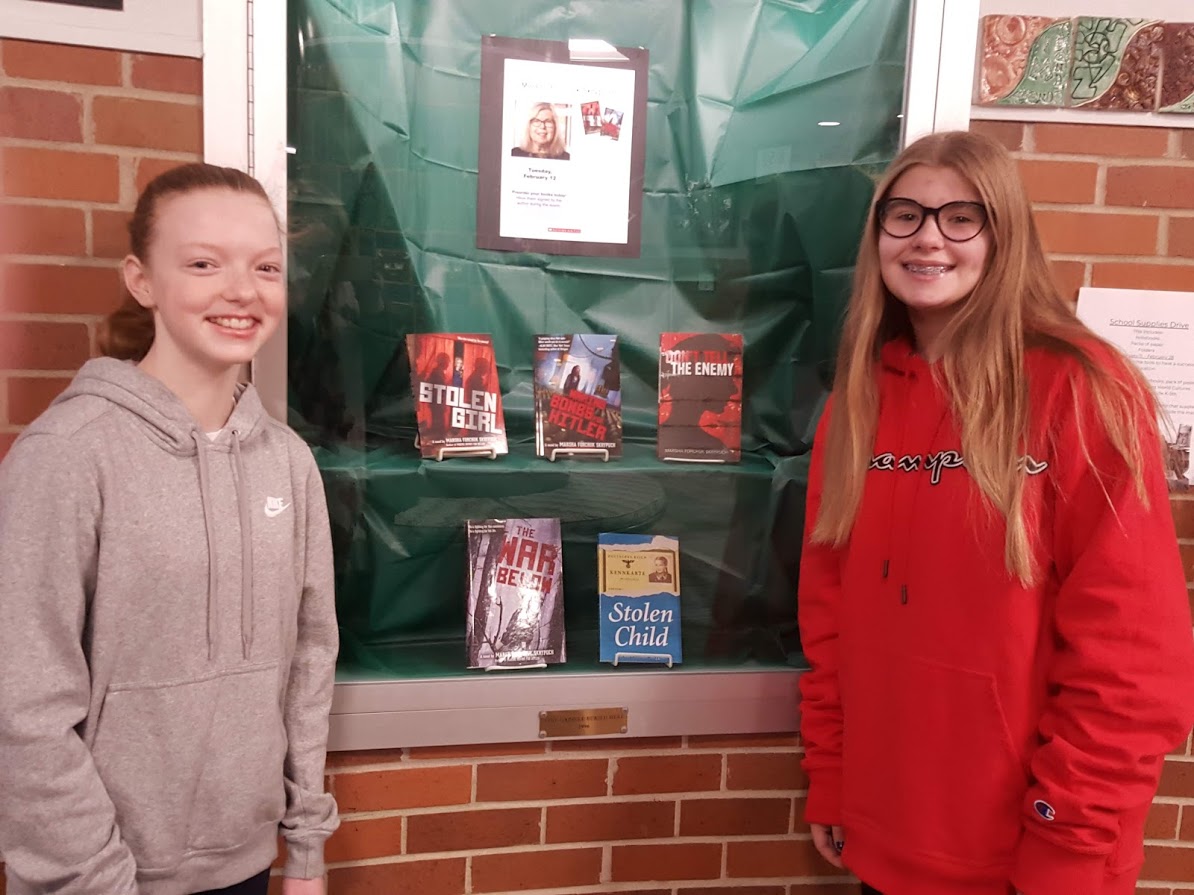
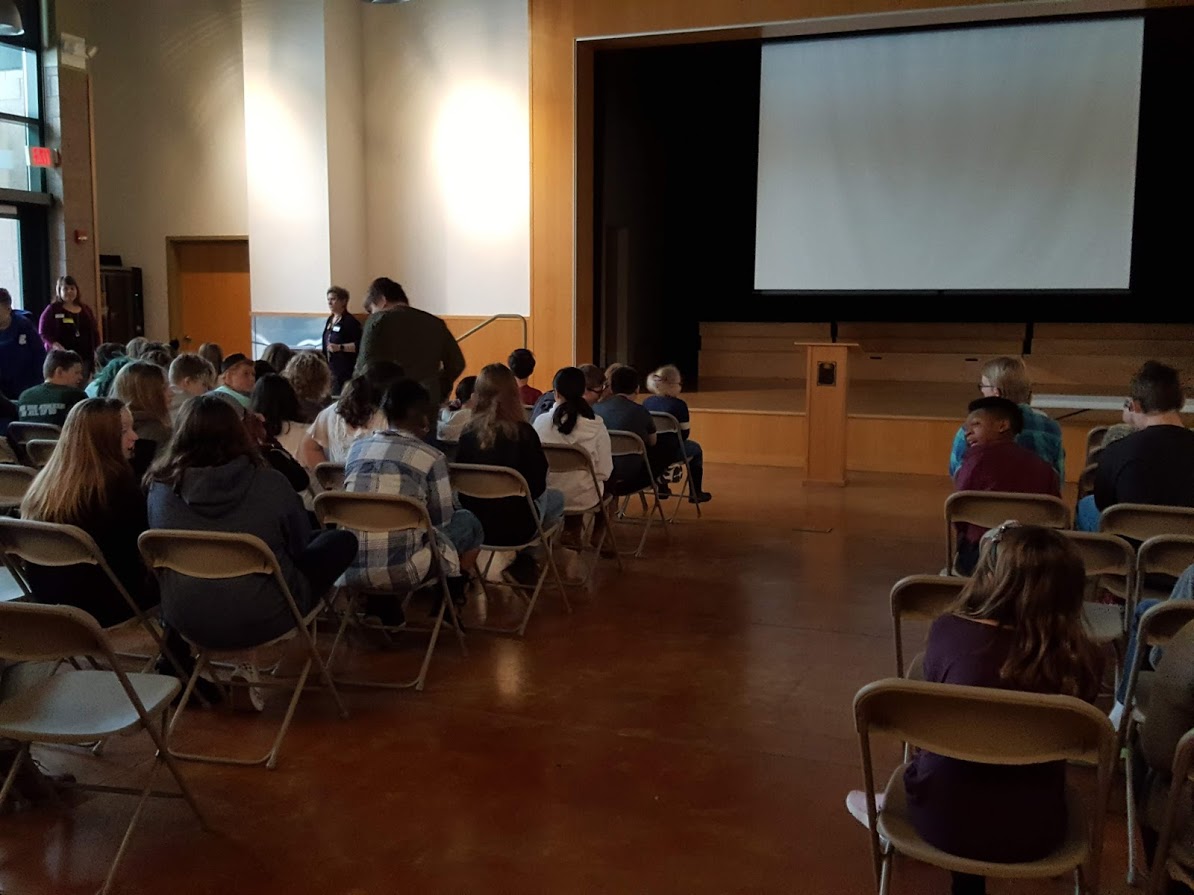
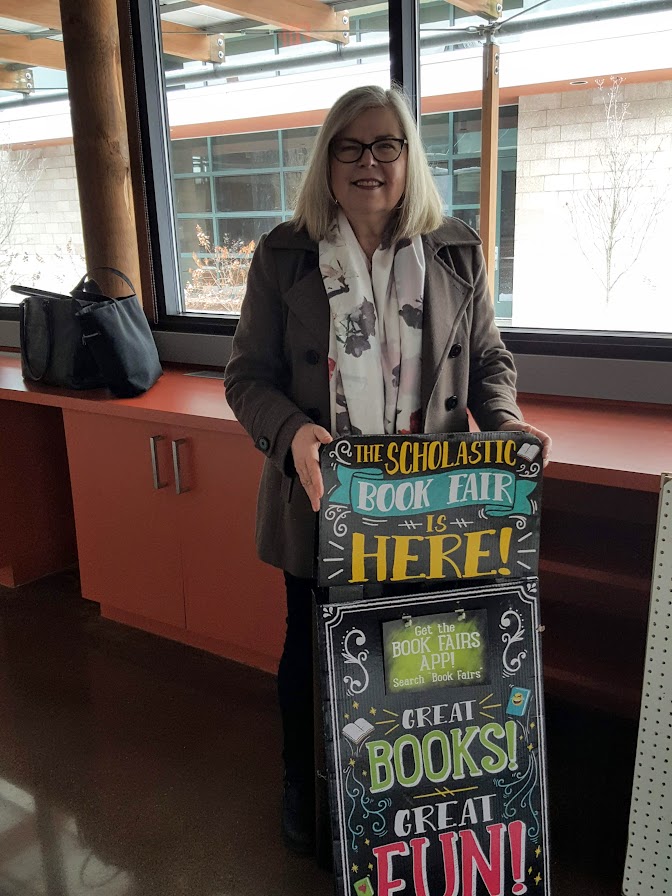
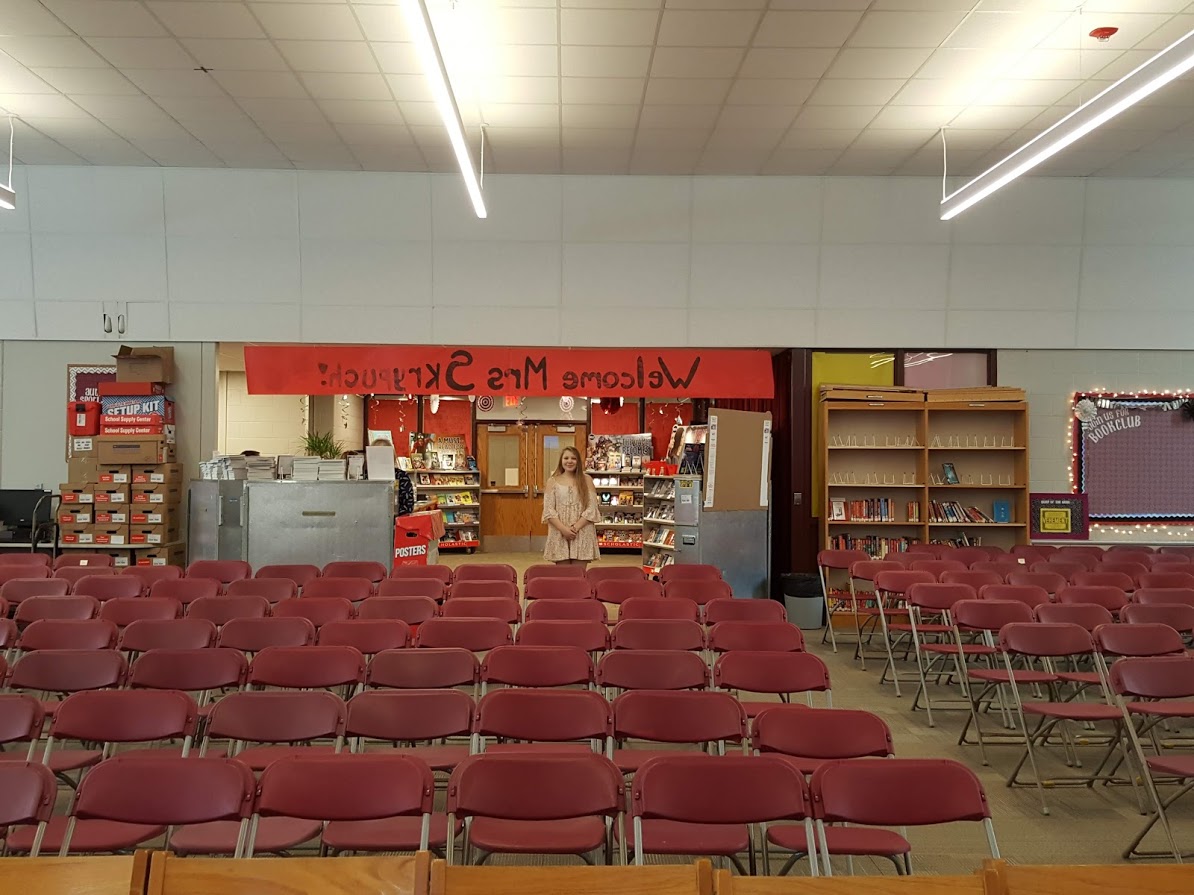

In conversation with Michelle Barker
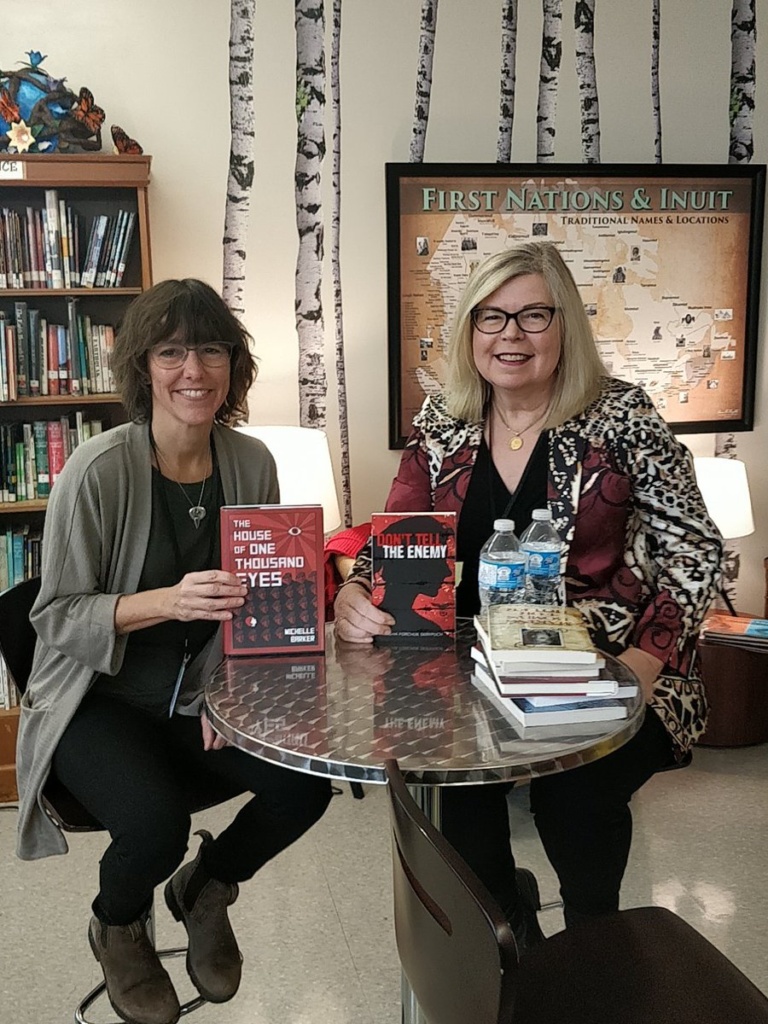
I admire Michelle Barker’s work and was thrilled with the opportunity to meet her in person and do a joint presentation on our newest books. Advanced placement English students at Notre Dame Catholic School participated in the thoughtful discussion.
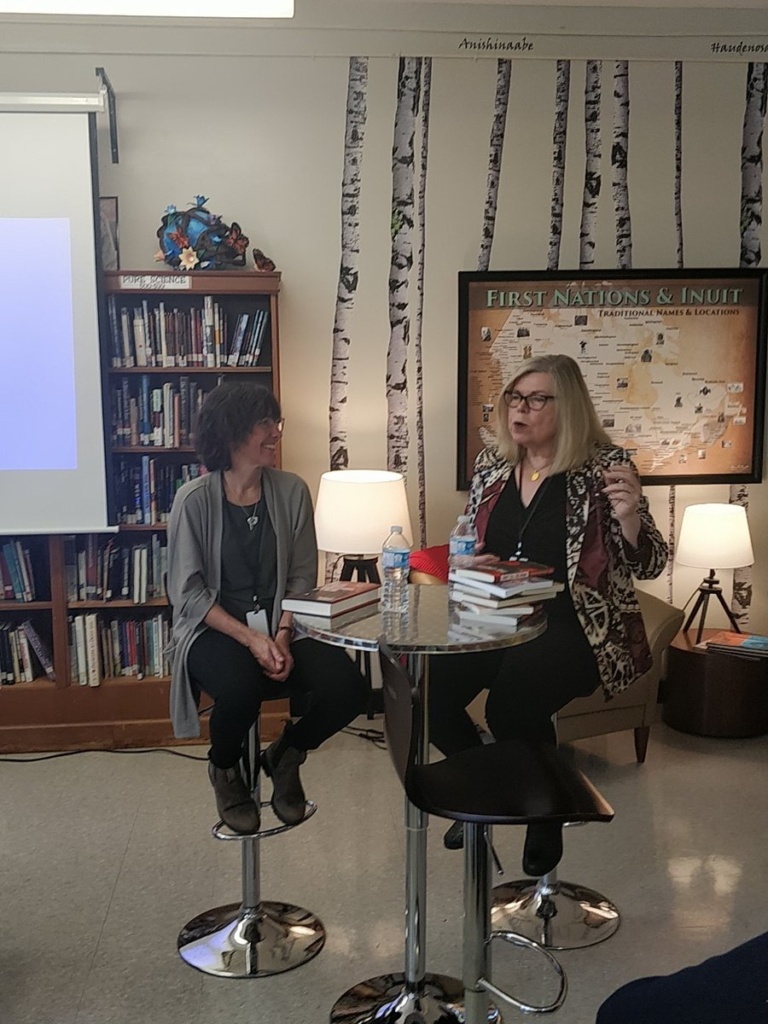
Superconference 2019

with Cinders McLeod 
Carmen Mok + Helaine Becker 
Karen Upper, JoAnne Richards and book creators! 
crashing Ruth Ohi’s signing 
Jennifer Mook-Sang, Werner Zimmerman
The OLA Superconference is such a great time to catch up with friends and fellow book geeks!
Literacy Day at Wesley Christian Academy
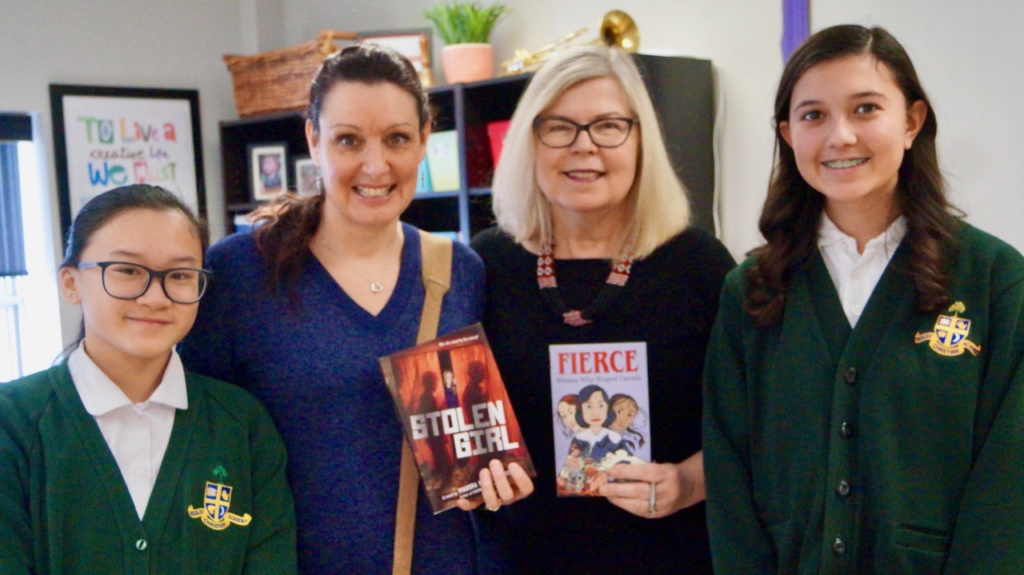
ILA Notable book
It’s nice to share recognition with my good friend Helaine Becker on this list of ILA Notable Books for a Global Society!

